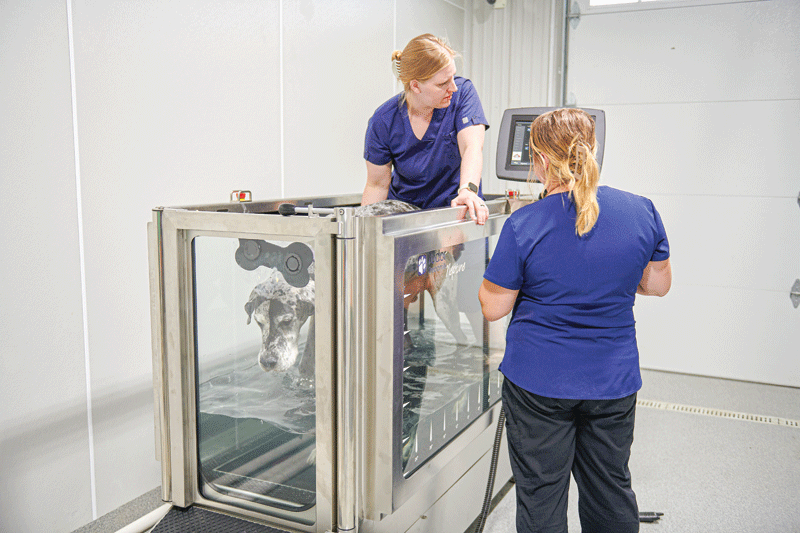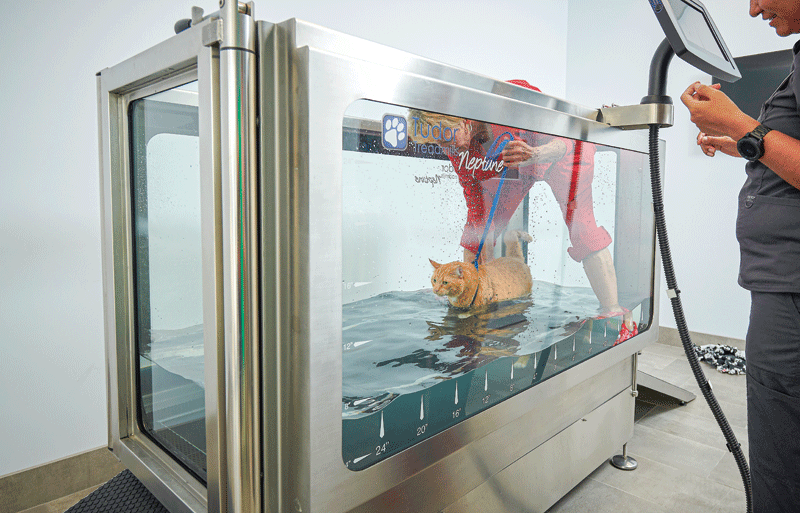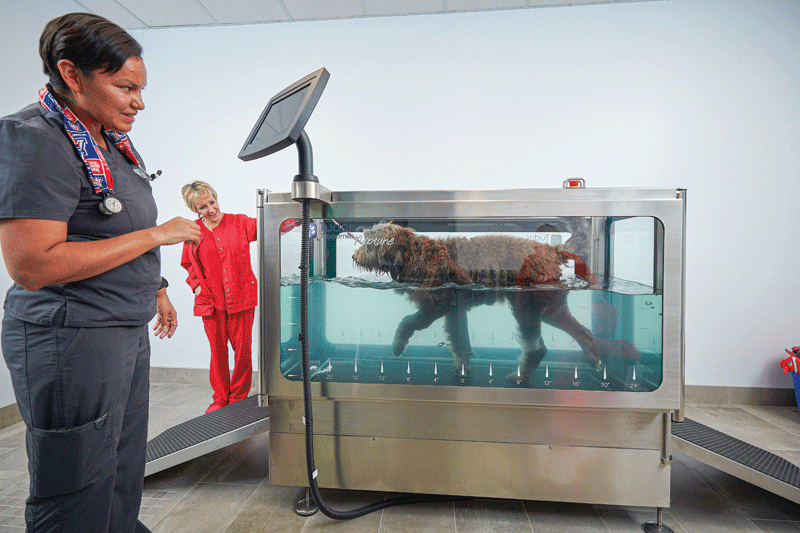
More owners want to do everything they can to keep their pet healthy. Desiree Garthe, DVM, CVA, knows firsthand how clients want to spend as much time as possible with their fur babies. It is one of the reasons she started Paradise Point Veterinary Clinic in Phoenix, Ariz.—she wanted to offer clients more than meds.
Dr. Garthe’s motivation to open her own practice came from her love for her patients. Her commitment to rehabilitation is showcased in the front window; her hydrotherapy treadmill is front and center of her clinic.
“When I first started practicing medicine, I would come to dead-end cases. It’d be like: ‘Oh no, there’s nothing more we can do.’ That just always bothered me,” says Garthe “There’s got to be something more that we can do for those pets!”
“I love having other options to treat pets and help them get better and make them stronger,” she adds. “I knew rehabilitation is in the forefront—and why not? You know, we have physical therapists when we have injuries. That’s part of our protocol. Why isn’t it for them? Then for business purposes, too, I thought it was a good field to get into that would set me apart from other hospitals in the area. I don’t have grooming, so I needed another revenue source.”
Garthe saw in her community, offering rehabilitation service not only matched her philosophy, but was a differentiator as well.
Let’s explore specs and costs to see if investing in a hydrotherapy treadmill is a fit, physically and financially, for your practice.
How to plan for it
When asked about space requirements for a hydrotherapy treadmill, hospital design specialist, Michael Reynolds, of Patterson Veterinary, recommends putting the pump and tank in a separate, adjacent room from the treadmill, in a 6 ft x 6 ft space.
“The treadmill alone would cover about 17 ft x 8 ft,” says Reynolds. “Separating it from the pump and tank would mean less noise, and also, would look better.”
Altogether, Reynolds says, the pump, tank room and the treadmill would need a minimum 17 ft x 12 ft space.

Generating extra revenue
Thinking through return on investment (ROI), Dave Carter of Tudor Treadmills gave a few examples: “We have clients who treat 16 patients per day. The biggest number I have heard is 23 per day.”
Across the country, Carter sees practices charging a wide range of fees. For instance, in rural areas of the Midwest or the South, a 30-minute session might cost $50. In more affluent regions of the West Coast and East Coast, rates might be up to $125.
Setting an average, the hourly rate between the highest and lowest, it would be $87.50. Assuming the clinic sees eight patients per day, that totals $700 daily; over a 260-day working year, it would total $182,000 in the first year.
“However, let’s be pragmatic,” Carter says, outlining a scenario of $50 per session. If a clinic serves six patients daily (three in the morning and three in the afternoon), the total daily revenue would be $300. Over 260 working days, this would total $78,000 in year one.
Further, Carter gave real-life specific examples from practices across the United States:
A practice in Alabama:
- $70 per session up to 30 minutes
- $80 for 31 to 60 minutes
- $700 package of 10 sessions
A practice in Oregon, which combined hydrotherapy and laser therapy packages:
- Single session: $95
- 10 sessions: $850 ($85 per session)
- 20 sessions: $1,500 ($75 per session)
A practice in Colorado:
- Initial consultation, including measurements, exercise, modalities, manual therapy, underwater treadmill, 45-60 minutes: $190
- Manual therapy/underwater treadmill, 30 minutes: $80
- Underwater treadmill, 15 minutes: $50
- Underwater treadmill, 30 minutes: $90
A practice in Michigan:
- Rehab consultation: $103
- Individual session: $100
- Six-session package: $578
Part of a total rehabilitation plan
Part of thinking through ROI on a hydrotherapy treadmill is use cases. Carter says he sees the treadmill used for pre- and post-operative rehabilitation, osteoarthritis, osteochondritis dissecans, hip and elbow dysplasia, cruciate ligament injuries, patella luxation, spinal injury or disease, fibrocartilaginous embolism, healing of fractures, dislocations, muscle strains, and sprains.
According to Carter, when used as a conservative approach to surgery, for weight management or post-op care, patients undergoing hydrotherapy have reduced pain, stiffness, and inflammation, increased range of motion in a controlled environment, improved muscle mass, re-educated gait patterns, increased blood flow to the tissues, increased flexibility, and better respiratory and cardiovascular functioning.
Dr. Joe Chow, medical director for Rusty Ridge Animal Center in Minooka, Ill., sees the treadmill as a part of a total regenerative and rehabilitative approach he offers at his practice.
“Not everyone’s going to do surgery, but we can manage clinical symptoms of osteoarthritis and pain with platelet-rich plasma and stem cell. Then we’ve got the hydrotherapy treadmill, which is going to help with our rehab of ortho surgeries as well as slowing down progressive degenerative joint disease,” says Dr. Chow.
A success story
“We didn’t use to have anything to offer when a client in a routine visit says something such as, ‘Oh, Sophie’s slowing down.’ Now it’s a different story. When we hear that, it’s not just a case of slowing down being normal,” says Jennifer Vitucci, DVM, CCRT. “There are more things we can do about it. We can intervene,” adds Dr. Vitucci, who has more than a decade of experience as a rehab therapist.
One of Vitucci’s favorite success stories involved an 11-year-old black Labrador named Lillie.
“When I had my first appointment with her, she was so weak the owners used a sling to bring her into the exam room. For a couple of months, she had barely walked unassisted.” The results were slow–but ultimately satisfying.
“When we started, all we could do was put her in the underwater treadmill, let her stay in it, and then drain it after three minutes because she started to fall,” Vitucci says. “Lillie came to me once a week, and we couldn’t turn the treadmill on for six visits. Eventually, that changed. Now, two years later, she goes on half-mile walks twice a day with her owners. They’re so happy.”
Theresa Hurley is a territory manager for Patterson Veterinary, based in Arizona. She has been with the company sixteen years and has helped hundreds of veterinarians build their dream practice.

